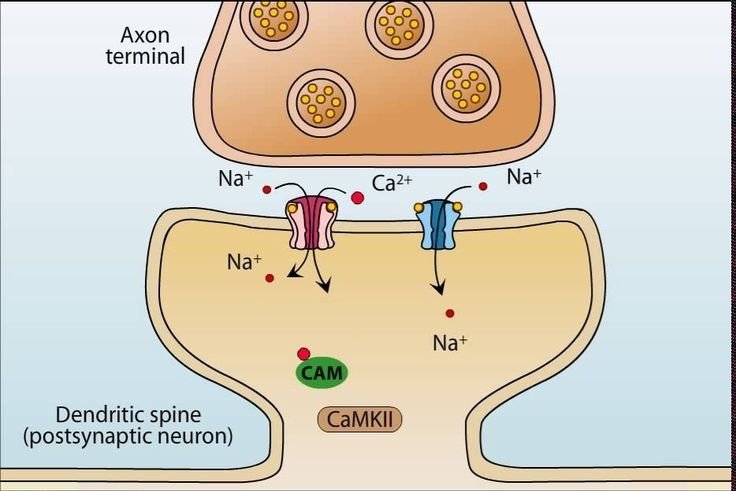Answer: Both AMPA and NMDA are glutamate receptors, but they play different roles in neuronal communication.
In the central nervous system, the main excitatory neurotransmitter is glutamate. Glutamate signals to the postsynaptic cell by activating different types of receptors. Although there are several glutamate receptors, two important types are called the AMPA receptors and NMDA receptors. These have been named because they can be selectively activated by the chemicals α-amino-3-hydroxy-5-methyl-4-isoxazolepropionic acid (AMPA) and N-methyl-D-aspartate (NMDA), respectively.
Both of these receptors are critically important for healthy nervous system function, and dysregulation of these receptors is known to lead to a variety of psychiatric conditions, ranging from schizophrenia (Ketamine as a pharmacological tool for the preclinical study of memory deficit in schizophrenia) to epilepsy (GRIN2A-related epilepsy and speech disorders: A comprehensive overview with a focus on the role of precision therapeutics).
Similarities between AMPA and NMDA receptors
AMPA and NMDA receptors bind to and are activated by the neurotransmitter glutamate
Glutamate is the most common neurotransmitter in the entire human brain. Glutamate is an amino acid that the body is not able to produce on its own. Much of the glutamate our body uses comes from dietary sources like glutamine. Glutamine is taken into presynaptic cells, where an enzyme called glutaminase converts it into glutamate, which is then packaged into vesicles for release. Glutamate is also converted by enzymes in glia.
During an action potential, glutamate is released into the synapse. These molecules then diffuse across the synapse, where they can bind to a specific location on the AMPA or NMDA receptors.
AMPA and NMDA receptors are non-selective cation channels
Both AMPA and NMDA glutamate receptors are transmembrane ion channels. This means that their protein structure is embedded within the cell membrane and has a special pore that allows ions to pass across into or out of the cell. Once a molecule of glutamate binds to and activates their AMPA or NMDA receptors under certain conditions, the receptors physically change shape. This causes the pore to open up. Now, cations can move across the cell membrane.
AMPA and NMDA receptors are non-selective cation channels, which mean that they let sodium (Na+) and potassium (K+), and in some cases, calcium (Ca2+) cross the cell membrane.
AMPA and NMDA receptors are both excitatory
When a molecule of glutamate activates the AMPA or NMDA receptors, the result of ion channel opening is flow of positively charged ions. Generally, the ion that moves across the cell membrane the most is sodium. Specifically, sodium wants to enter into the cell.
There are two reasons sodium wants to move into the cell. One is that it wants to move down its chemical gradient. There is a much higher concentration of sodium outside the cell compared to inside, roughly ten times more. Ions want to be an area of low concentration, if possible.
The second reason is that the inside of the cell is usually negatively charged. Sodium carries a positive charge, so it is attracted to the negative charges inside the cell.
When sodium enters into the cell, it carries a positive charge. This charge makes the cell membrane become more positive, thereby depolarizing it and bringing the cell closer to the action potential threshold. Therefore, activation of these receptors make the cell more likely to fire an action potential.
Differences between AMPA and NMDA receptors
AMPA receptors may or may not be calcium permeable. NMDA receptors are calcium permeable.
Although both glutamate receptors are cation permeable and therefore excitatory, calcium may or may not be the charge carrying cation that enters the cell through these receptors. For AMPA receptors, their ability to pass calcium depends on the subunits that make up the receptor. AMPA receptors are made up of four subunits per channel. If an AMPA receptor contains the subunit GluR2, the properties of the pore change so that the receptor is calcium permeable. Many AMPA receptors do not contain a GluR2 subunit, and these AMPA receptors are calcium impermeable.
But, NMDA receptors are intrinsically permeable to both sodium and calcium, regardless of the subunits that make up the receptor.
NMDA receptors, but not AMPA receptors, can be blocked by magnesium ion
The concentration of magnesium in the extracellular space of a mammalian cell is relatively low, roughly 1 millimolar. However, the magnesium ion (Mg2+) is a large and bulky ion that can interfere with passage of other ions through the NMDA receptor. The AMPA receptor does not have space for Mg2+ to block the pore.
NMDA receptors are more involved with synaptic plasticity
Synaptic plasticity is believed to be the underlying cellular mechanism that explains complex behavioral phenomena such as learning or memory. At the level of neurons, examples of synaptic plasticity include long-term potentiation, the persistent strengthening of a synapse, and long-term depression, a weakening of a synapse.
These cellular observations are likely a consequence of NMDA receptor activation. Through a series of signaling molecules, activation of NMDA receptors under depolarizing conditions cause an influx of calcium ions, which trigger activation of enzymes such as CaMKII. This molecule can then signal through a variety of mechanisms to enhance synaptic strength.
These findings were demonstrated in a Nature publication from 1995 (Distinct components of spatial learning revealed by prior training and NMDA receptor blockade), where the researchers discovered that performance on the Morris water maze worsened became worse after treatment with an NMDA receptor antagonist.
